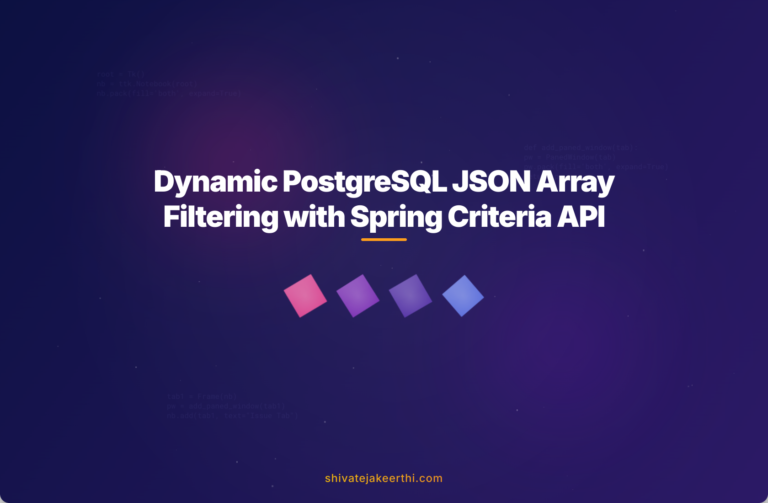When working with Spring and Hibernate, developers frequently encounter situations demanding highly dynamic queries. You can’t always rely on standard JPA annotations or simple SQL because real-world applications often require querying complex data structures like JSON arrays stored in databases such as PostgreSQL. In these cases, the Criteria API becomes your friend, allowing dynamic query construction without compromising on database portability or maintainability.
Why Use Spring Criteria API in Dynamic Queries?
Hibernate’s Criteria API provides an object-oriented, type-safe approach for creating database queries programmatically. Instead of hard-coding SQL or JPQL queries into your codebase, Criteria API empowers you to build queries dynamically based on conditions that might change at runtime.
If you’ve experienced frequent changes in search or filtering requirements, you know how annoying it is to continuously rewrite raw SQL statements. By leveraging Criteria API, you gain flexibility and robustness—two essential ingredients in scalable application development.
Filtering JSON Array Fields With Criteria API
Working with databases like PostgreSQL often involves storing data in JSONB columns to manage semi-structured data conveniently. JSON arrays nested within these fields sometimes make direct filtering challenging. However, PostgreSQL’s powerful built-in function named jsonb_array_elements comes to rescue by letting you interact directly with each element of a JSON array.
Through Spring Criteria API and Hibernate, you can tap into these native database functions, filtering JSON array fields effectively. Utilizing the CriteriaBuilder, developers can incorporate raw SQL functions elegantly into query-building logic.
Implementing Multiconditional Filtering With CriteriaBuilder
Suppose you have a PostgreSQL database table named products, containing a column tags as JSON arrays, like the following example:
[
{"name": "electronics", "priority": 1},
{"name": "gadgets", "priority": 2}
]
You want to extract and filter records based on certain tags, say filtering all products containing the tag “electronics”. Let’s dive into a step-by-step example illustrating this scenario clearly.
Step 1: Initialize CriteriaBuilder and Predicate List
Begin by obtaining the CriteriaBuilder from your EntityManager, prepare your query, and initialize Predicate lists:
CriteriaBuilder cb = entityManager.getCriteriaBuilder();
CriteriaQuery<Product> query = cb.createQuery(Product.class);
Root<Product> productRoot = query.from(Product.class);
List<Predicate> predicates = new ArrayList<>();
Step 2: Use jsonb_array_elements Function
To use PostgreSQL’s function jsonb_array_elements, Hibernate CriteriaBuilder lets you call it directly with the function() method.
Here’s how you create this expression using CriteriaBuilder:
Expression<String> jsonElements = cb.function(
"jsonb_array_elements",
String.class,
productRoot.get("tags")
);
Step 3: Incorporating Existing Conditions
Your next step is to access specific fields within extracted JSON elements, like “name.” You may want to filter tags where the “name” matches certain values. To achieve this, the query must handle further JSON path extraction robustly.
Here’s how you extract fields from JSON elements using Criteria API’s function method again with PostgreSQL’s JSON operators:
Expression<String> tagName = cb.function(
"jsonb_extract_path_text",
String.class,
jsonElements,
cb.literal("name")
);
Now you can easily add your targeted condition to the Predicate list:
predicates.add(tagName.in("electronics", "gadgets"));
You’re creating a multiconditional filtering environment by simply adjusting conditions, adding criteria dynamically, and integrating database JSON functions seamlessly.
Executing and Processing the Query Results
After constructing all conditions dynamically, let’s finalize your CriteriaQuery, run it with the entity manager, and fetch the filtered results effectively:
query.select(productRoot).where(cb.and(predicates.toArray(new Predicate[0])));
List<Product> filteredProducts = entityManager.createQuery(query).getResultList();
Post-query processing can involve iterating over results and possibly further processing of the JSON fields or mapping these entities into respective business objects in a performant way, as illustrated in this related article about JSON parsing on my JavaScript category page.
Extending for Additional Conditions Dynamically
Because Criteria API is flexible, developers can add more conditions easily. For example, filtering products with a certain tag “electronics” _and_ priority greater than a specific value can be done by extending the criteria query with a further extraction:
Expression<String> tagPriority = cb.function(
"jsonb_extract_path_text",
String.class,
jsonElements,
cb.literal("priority")
);
predicates.add(cb.gt(cb.function("CAST", Integer.class, tagPriority, cb.literal("integer")), 1));
This dynamic approach proved invaluable when needing more sophisticated searching techniques, making applications more adaptable.
Best Practices and Optimization Techniques
When dealing with JSON filtering using PostgreSQL’s jsonb_array_elements, performance can be impacted if not handled correctly. Here are key suggestions:
- Indexing and Optimization: Utilize PostgreSQL’s native support for GIN indexes on JSON fields for boosted query performance.
- Cache Frequently-Queried Results: To reduce database loads, consider caching frequent query results using tools like Hibernate 2nd-level cache or Redis.
- Code Readability and Maintainability: Use helper methods for repetitive criteria-building tasks, and encapsulate JSON extraction logic clearly.
Benefits of Leveraging Spring Criteria API
Filtering JSON arrays effectively with Criteria API saves development effort, reduces SQL injection risk, and provides dynamic and efficient queries. When considering a modern Spring application interacting frequently with JSON data, Criteria API offers significant advantages including:
- Enhanced flexibility for dynamic and conditional queries.
- Code maintainability with readable, type-safe queries.
- Database-agnostic APIs, minimizing vendor lock-in.
By consistently applying these methods, you greatly improve your application’s querying capabilities and speed up future enhancements.
The versatility of Spring Criteria API coupled with PostgreSQL’s JSON functions transforms traditionally complex database operations into manageable tasks. Implemented well, these techniques result in robust and scalable applications.
Are you already using Criteria API for dynamic queries involving JSON arrays? Share your experience or challenges below!



0 Comments